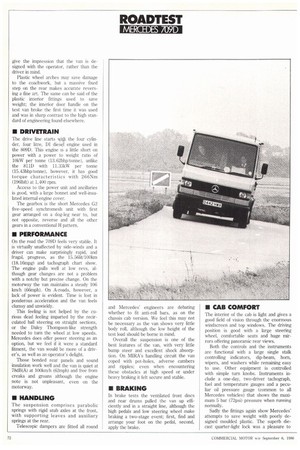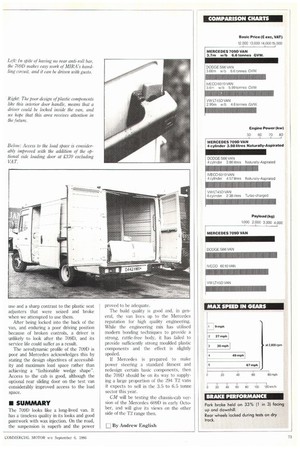STRONG CONTENDER
Page 74

Page 76

Page 77

If you've noticed an error in this article please click here to report it so we can fix it.
Mercedes aims to maintain its share of the 3.5 to 7.5-tonne market with the new T2 range. It faces tough opposition from the likes of Dodge and VW — CM looks at its chances.
• Any manufacturer launching a new model into the artificially-bounded 3.5 to 7.5 tonne market, has got to be fairly confident of obtaining a good share. In the UK, after all, this sector has slumped by almost 90% since the mid-1970s to about 5,000 units per year.
Mercedes is confident — and has backed its hunch with sufficient market research to be in a position to split the market. First into weight-sensitive (7.5 tonne) and nor-weight sensitive customers (everyone else). SeCond, into some 1,400 differAnt customers for the number of model variants they claim to offer.
The 709D van and chassis cab are bounded on the 7.5 tonne limit by their big sister, the 811D and the more powerful 814 haulage chassis. At the lower end of the market are the other T2 krivatives, the 507D, and the 6091). Since the launch, in July this year, Mercedes has registered 50 vehicles in the 12 range and hopes to sell around 495 this year, with 85% of those in the 3.5 to 6.5 tonne sector. The split between vans and chassis cabs is projected to be 70/30, so the 709D van is the most popular type of derivative, in the most popular part of the market.
The van tested is the most basic 709D, with a 3.7m wheelbase and the low roof, although the optional side load ing door and headlamp wash/wipe were included. A high roof and 4.2m wheelbase is available as well as a host of options including automatic gearbox, exhaust brake and, most significantly, power steering.
• CARRYING CAPACITY
The load space is a cavernous 1.9x4.05x1.78m, with only the wheel arches intruding 430mm from each side. Al] extraneous detail is faired into the sides along with location plugs for internal panelling, if desired.
This space is well thought out; the roof sides and bulkheads have shaped, cut-out panels for sky lights and windows and the interior lighting is controlled by a neat push on/off switch.
The panels are bonded to the body members in an effort to reduce the aerodynamic drag and movement associated with rivets. This also negates the need for side guards as the resultant structure withstands side impact sufficiently in the eyes of the law.
Unfortunately some detail features 110. give the impression that the van is designed with the operator, rather than the driver in mind.
Plastic wheel arches may save damage to the coachwork, but a massive fixed step on the rear makes accurate reversing a fine art. The same can be said of the plastic interior fittings used to save weight; the interior door handle on the test van broke the first time it was used and was in sharp contrast to the high standard of engineering found elsewhere.
MI DRIVETRAIN
The drive line starts witti the four cylinder, four litre, 131 diesel engine used in the 8091). This engine is a little short on power with a power to weight ratio of 10kW per tonne (13.62bhpitonne), unlike the 8111) with 11.33kW per tonne (15.43bhp/tonne), however, it has good torque characteristics with 266Nm (1961bft) at 1,400 rpm.
Access to the power unit and ancillaries is good, with a large bonnet and well-insulated internal engine cover.
The gearbox is the short Mercedes G2 five-speed synchromesh unit with first gear arranged on a dog-leg near to, but not opposite, reverse and all the other gears in a conventional H pattern.
• PERFORMANCE
On the road the 7091) feels very stable. It is virtually unaffected by side-winds and a driver can make surprisingly rapid, and frugal, progress, as the 15.561it/100km (18.16mpg) and tachograph chart show. The engine pulls well at low revs, although gear changes are not a problem with a notchy but precise change. On the motorway the van maintains a steady 106 km/h (66mph). On A-roads, however, a lack of power is evident. Time is lost in ponderous acceleration and the van feels clumsy and unwieldy.
This feeling is not helped by the curious dead feeling imparted by the recirculated ball steering on straight sections, or the Daley Thompson-like strength needed to turn the wheel at low speeds. Mercedes does offer power steering as an option, but we feel if it were a standard fitment, the van would be more of a driver's, as well as an operator's delight.
Those bonded rear panels and sound insulation work well and the van is quiet at 78dB(A) at 100kmili (62mph) and free from creaks and groans although the engine note is not unpleasant, even on the motorway.
• HANDLING
The suspension comprises parabolic springs with rigid stub axles at the front, with supporting leaves and auxiliary springs at the rear.
Telescopic dampers are fitted all round and Mercedes' engineers are debating whether to fit anti-roll bars, as on the chassis cab version. We feel this may not be necessary as the van shows very little body roll, although the low height of the test load should be borne in mind.
Overall the suspension is one of the best features of the van, with very little bump steer and excellent shock absorption. On MIRA's handling circuit the van coped with pot-holes, adverse cambers and ripples; even when encountering these obstacles at high speed or under heavy braking it felt secure and stable.
• BRAKING
In brake tests the ventilated front discs and rear drums pulled the van up efficiently and in a straight line, although the high pedals and low steering wheel make braking a two-stage event; first, find and arrange your foot on the pedal, second, apply the brake.
• CAB COMFORT
The interior of the cab is light and gives a good field of vision through the enormous windscreen and top windows. The driving position is good with a large steering wheel, comfortable seats and huge mirrors offering panoramic rear views.
Both the controls and the instruments are functional with a large single stalk controlling indicators, dip-beam, horn, wipers, and washers while remaining easy to use. Other equipment is controlled with simple turn knobs. Instruments include a one-day, two-driver tachograph, fuel and temperature gauges and a peculiar oil pressure gauge (common to all Mercedes vehicles) that shows the maximum 5 bar (72psi) pressure when running normally.
Sadly the fittings again show Mercedes' attempts to save weight with poorly designed moulded plastic. The superb diecast quarter-light lock was a pleasure to use and a sharp contrast to the plastic seat adjusters that were seized and broke when we attempted to use them.
After being locked into the back of the van, and enduring a poor driving position because of broken controls, a driver is unlikely to look after the 709D, and its service life could suffer as a result.
The aerodynamic profile of the 709D is poor and Mercedes acknowledges this by stating the design objectives of accessibility and maximum load space rather than achieving a "fashionable wedge shape". Access to the cab is good, although the optional rear sliding door on the test van considerably improved access to the load space.
• SUMMARY
The 709D looks like a long-lived van. It has a timeless quality in its looks and good paintwork with wax injection. On the road, the suspension is superb and the power proved to be adequate.
The build quality is good and, in general, the van lives up to the Mercedes reputation for high quality engineering. While the engineering mix has utilised modern bonding techniques to provide a strong, rattle-free body, it has failed to provide sufficiently strong moulded plastic components and the effect is slightly spoiled.
If Mercedes is prepared to make power steering a standard fitment and redesign certain basic components, then the 7091) should be on its way to supplying a large proportion of the 294 T2 vans it expects to sell in the 3.5 to 6.5 tonne sector this year.
CM will be testing the chassis-cab version of the Mercedes 6091) in early October, and will give its views on the other side of the T2 range then.
Li By Andrew English
















































































































